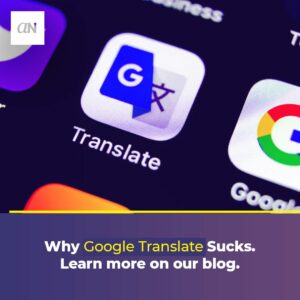People dedicated their lives to learning and understanding different languages. It was once solely an art, but language technology has made major advancements since the birth of the Internet. Where once you would have needed a Spanish to English dictionary to put together the most basic sentence in another language, you can now copy/paste full paragraphs into Google Translate in order to get a workable text in the language you best understand. A lot of people utilize this translation technology with fantastic results, but it is crucial to understand its limitations.
The one thing Google Translate cannot help you with is bilingual marketing. Bilingual marketing is challenging and incredibly nuanced. If you mistranslate, native speakers will be able to pick it out quickly, and they will subconsciously conclude that you do not understand them. Consider English marketing. If you see an advertisement that says “Very good company work with us please results,” are you going to trust that service? Probably not. People choose to work with companies that understand their experiences. Marketing that is slightly off the mark is incredibly off-putting.
In terms of multicultural marketing, Google Translate sucks. That is because a word-to-word translation technology misses the nuance and expressions that native and even fluent speakers understand. To illustrate the point, let’s look at an example.
The Spanish phrase “no pasa nada” literally translates to “nothing happens.” That may sound like a phrase you may not use much, but that is not the case. In Spanish, “no pasa nada” signifies “don’t worry about it.” If you were to bump into someone on the street, a Spanish speaker might say “no pasa nada” in order to assure you that they were not bothered. They are not literally saying “nothing happens.” If you type “no pasa nada” in Google Translate, they give you the literal translation, not the nuance. So if you write a marketing copy that includes the phrase “no pasa nada” and plug it into Google Translate, you are going to wind up with a stilted and strange English copy that will not resonate with anyone.
That is just one of many examples. Google Translate is fantastic for getting the gist of what your copy means. Still, good quality marketing copy necessitates an empathetic connection with your audience; Google Translate cannot do that. In contrast, a native Spanish speaker will be able to utilize idioms, cultural understanding, and expressive phrases to craft copy that will resonate with any native speaker.
The Spanish-speaking market is vast, and it is currently largely under-served. If you can craft high-quality and empathetic Spanish marketing copy, you can convert a lot of new customers. Do not cheap out on multicultural marketing. If you do, the market will notice, and they will retreat from your brand. Remember that Google Translate is great for checking a menu, but it is inadequate for translating highly sophisticated marketing content. Instead, hire a bilingual marketing expert who can help you to target the Spanish speaking market effectively. Your bottom line will thank you.





